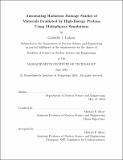| dc.contributor.advisor | Michael P. Short. | en_US |
| dc.contributor.author | Ledoux, Gabrielle J | en_US |
| dc.contributor.other | Massachusetts Institute of Technology. Department of Nuclear Science and Engineering. | en_US |
| dc.date.accessioned | 2017-01-30T18:51:03Z | |
| dc.date.available | 2017-01-30T18:51:03Z | |
| dc.date.copyright | 2016 | en_US |
| dc.date.issued | 2016 | en_US |
| dc.identifier.uri | http://hdl.handle.net/1721.1/106696 | |
| dc.description | Thesis: S.B., Massachusetts Institute of Technology, Department of Nuclear Science and Engineering, 2016. | en_US |
| dc.description | This electronic version was submitted by the student author. The certified thesis is available in the Institute Archives and Special Collections. | en_US |
| dc.description | Cataloged from student-submitted PDF version of thesis. | en_US |
| dc.description | Includes bibliographical references (page 81). | en_US |
| dc.description.abstract | Understanding radiation and corrosion damage in nuclear materials has become increasingly important in reactor design considerations. However, running irradiation damage studies in nuclear reactors is expensive and time-consuming. Thus, accurate, quick simulations have become more attractive to researchers studying alternative materials in nuclear reactors. This thesis investigates the possibility of automating irradiation damage studies using ion stopping range simulations coupled with heat generation simulations to find the change in temperature across a sample. The range simulations generate 1D slabs with different thicknesses and bombards them with high-energy proton beams. The slabs are automatically sorted, a meshed geometry is created, and the recoil energy information is entered into a multiphysics Finite- Element solver. Ultimately, the optimal beam current for which the temperature gradient across a coolant-sample geometry is less than 5 K is predicted. This thesis examines the possibility of automating the entire simulation process so that many materials and slab thicknesses can be tested for resistance to temperature change (and thus implying specifics of radiation damage effects). | en_US |
| dc.description.statementofresponsibility | by Gabrielle J. Ledoux. | en_US |
| dc.format.extent | 81 pages | en_US |
| dc.language.iso | eng | en_US |
| dc.publisher | Massachusetts Institute of Technology | en_US |
| dc.rights | MIT theses are protected by copyright. They may be viewed, downloaded, or printed from this source but further reproduction or distribution in any format is prohibited without written permission. | en_US |
| dc.rights.uri | http://dspace.mit.edu/handle/1721.1/7582 | en_US |
| dc.subject | Nuclear Science and Engineering. | en_US |
| dc.title | Automating radiation damage studies of materials irradiated by high-energy protons using multiphysics simulations | en_US |
| dc.type | Thesis | en_US |
| dc.description.degree | S.B. | en_US |
| dc.contributor.department | Massachusetts Institute of Technology. Department of Nuclear Science and Engineering | |
| dc.identifier.oclc | 969845011 | en_US |
